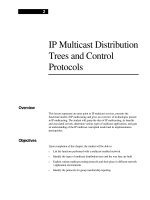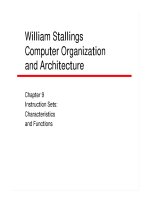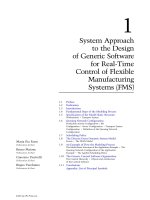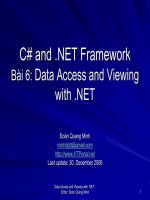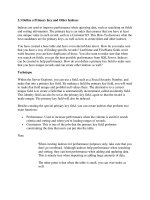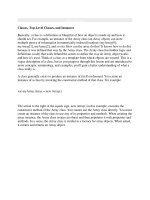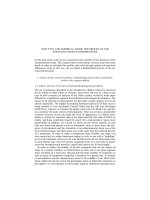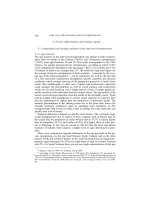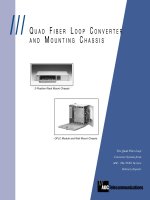Tài liệu Communicating Uncertainties in Weather and Climate Information docx
Bạn đang xem bản rút gọn của tài liệu. Xem và tải ngay bản đầy đủ của tài liệu tại đây (1.18 MB, 69 trang )
A Workshop Summary
Communicating
Uncertainties in
Weather and Climate
Information
Elbert W. Friday, Jr., Rapporteur
Board on Atmospheric Sciences and Climate
Division on Earth and Life Studies
THE NATIONAL ACADEMIES PRESS
Washington, D.C.
www.nap.edu
THE NATIONAL ACADEMIES PRESS 500 Fifth Street, N.W. Washington, D.C. 20001
NOTICE: The project that is the subject of this summary was approved by the Governing Board of
the National Research Council, whose members are drawn from the councils of the National Acad-
emy of Sciences, the National Academy of Engineering, and the Institute of Medicine. The members
of the group responsible for the planning of the workshop were chosen for their special competences
and with regard for appropriate balance.
Support for this project was provided by the National Science Foundation and the National Aeronau-
tics and Space Administration under Grant No. ATM-0135923, the U.S. Environmental Protection
Agency under Grant No. X-82875501, and the National Oceanic and Atmospheric Administration
under Contract No. 50-DGNA-1-90024. Any opinions, findings, and conclusions or recommenda-
tions expressed in this publication are those of the author(s) and do not necessarily reflect those of the
sponsors or their subagencies.
International Standard Book Number 0-309-08540-3
Additional copies of this report are available from the National Academies Press, 500 Fifth Street,
N.W., Lockbox 285, Washington, DC 20055; (800) 624-6242 or (202) 334-3313 (in the Washington
metropolitan area); Internet, .
Cover: Tornado near Verden, Oklahoma, as it progressed on to Oklahoma City, May 3, 1999.
Copyright by Howard B. Bluestein.
Copyright 2003 by the National Academy of Sciences. All rights reserved.
Printed in the United States of America
The National Academy of Sciences is a private, nonprofit, self-perpetuating society of
distinguished scholars engaged in scientific and engineering research, dedicated to the
furtherance of science and technology and to their use for the general welfare. Upon the
authority of the charter granted to it by the Congress in 1863, the Academy has a mandate
that requires it to advise the federal government on scientific and technical matters.
Dr. Bruce M. Alberts is president of the National Academy of Sciences.
The National Academy of Engineering was established in 1964, under the charter of the
National Academy of Sciences, as a parallel organization of outstanding engineers. It is
autonomous in its administration and in the selection of its members, sharing with the
National Academy of Sciences the responsibility for advising the federal government.
The National Academy of Engineering also sponsors engineering programs aimed at
meeting national needs, encourages education and research, and recognizes the superior
achievements of engineers. Dr. Wm. A. Wulf is president of the National Academy of
Engineering.
The Institute of Medicine was established in 1970 by the National Academy of Sciences
to secure the services of eminent members of appropriate professions in the examination
of policy matters pertaining to the health of the public. The Institute acts under the
responsibility given to the National Academy of Sciences by its congressional charter to
be an adviser to the federal government and, upon its own initiative, to identify issues of
medical care, research, and education. Dr. Harvey V. Fineberg is president of the Institute
of Medicine.
The National Research Council was organized by the National Academy of Sciences in
1916 to associate the broad community of science and technology with the Academy’s
purposes of furthering knowledge and advising the federal government. Functioning in
accordance with general policies determined by the Academy, the Council has become the
principal operating agency of both the National Academy of Sciences and the National
Academy of Engineering in providing services to the government, the public, and the
scientific and engineering communities. The Council is administered jointly by both
Academies and the Institute of Medicine. Dr. Bruce M. Alberts and Dr. Wm. A. Wulf are
chair and vice chair, respectively, of the National Research Council.
www.national-academies.org
v
BOARD ON ATMOSPHERIC SCIENCES AND CLIMATE
ERIC J. BARRON (chair), Pennsylvania State University, University Park
SUSAN K. AVERY,* University of Colorado/CIRES, Boulder
RAYMOND J. BAN, The Weather Channel, Inc., Atlanta, Georgia
HOWARD B. BLUESTEIN, University of Oklahoma, Norman
STEVEN F. CLIFFORD, University of Colorado/CIRES, Boulder
GEORGE L. FREDERICK, Vaisala, Inc., Boulder, Colorado
JUDITH L. LEAN, Naval Research Laboratory, Washington, D.C.
MARGARET A. LEMONE, National Center for Atmospheric Research,
Boulder, Colorado
MARIO J. MOLINA, Massachusetts Institute of Technology, Cambridge
ROGER A. PIELKE, JR.,* University of Colorado/CIRES, Boulder
MICHAEL J. PRATHER, University of California, Irvine
WILLIAM J. RANDEL, National Center for Atmospheric Research, Boulder,
Colorado
ROBERT T. RYAN,* WRC-TV, Washington, D.C.
THOMAS F. TASCIONE, Sterling Software, Bellevue, Nebraska
ROBERT A. WELLER,* Woods Hole Oceanographic Institution, Massachusetts
ERIC F. WOOD,* Princeton University, New Jersey
Ex Officio Members
EUGENE M. RASMUSSON, University of Maryland, College Park
ERIC F. WOOD, Princeton University, New Jersey
NRC Staff
CHRIS ELFRING, Director
ELBERT W. (JOE) FRIDAY, JR., Senior Scholar
LAURIE S. GELLER, Senior Program Officer
PETER A. SCHULTZ, Senior Program Officer
VAUGHAN C. TUREKIAN, Program Officer
ELIZABETH A. GALINIS, Project Assistant
ROB GREENWAY, Project Assistant
DIANE L. GUSTAFSON, Administrative Associate
ROBIN MORRIS, Financial Officer
* Through December 2001
vii
Preface
Each year, typically in the summer, the Board on Atmospheric Sciences and
Climate selects a topic for special study (often called our “summer study”). Our
goal is to organize an informal workshop where scientists and agency staff can
share information about current issues in the atmospheric sciences, meteorology,
and climate. These events are a forum for frank discussions and creative inter-
action, and sometimes lead us to develop more in-depth activities.
Based on a suggestion from the Federal Committee for Meteorological Ser-
vices and Supporting Research, a committee chaired by the Administrator of the
National Oceanic and Atmospheric Administration (NOAA) whose members
include senior policy executives of the 14 federal agencies that are producers or
users of weather and climate information, the topic selected for the August 2001
summer study was the growing concern for the proper communication of uncer-
tainties in weather and climate information. We elected to use a series of case
studies to look at actual examples of the communication of weather information
and to see if these examples could provide insights that might lead, in time, to
new ideas and approaches.
This report is the product of the workshop held at the J. Erik Jonsson Woods
Hole Center in Woods Hole, Massachusetts, August 7-11, 2001, and was sponsored
by the U.S. Environmental Protection Agency, National Oceanic and Atmo-
spheric Administration, National Aeronautics and Space Administration, and
National Science Foundation. The agenda for the workshop is presented in
Appendix A and workshop participants are identified in Appendix B. As the
product of a workshop, this report does not contain findings or recommendations
but instead represents an overview of discussions that occurred during the work-
viii PREFACE
shop. Each case study does contain a section, “Remaining Challenges,” that
summarizes what the workshop participants saw as critical next steps. In addi-
tion, a new National Research Council report on public-private partnerships in
weather and climate services (expected mid 2003) will provide detailed discus-
sion of the relationships among the key participants in weather forecasting (i.e.,
the public, private, and academic sectors).
The National Academies and the Board on Atmospheric Sciences and Cli-
mate wish to thank the speakers and participants who contributed their time and
energy to this workshop. This kind of activity is an important mechanism for
focusing discussion on issues and highlighting opportunities for future work.
Chris Elfring
Director, BASC
ix
Acknowledgment of Reviewers
This workshop summary has been reviewed in draft form by individuals
chosen for their diverse perspectives and technical expertise, in accordance with
procedures approved by the National Research Council’s Report Review Com-
mittee. The purpose of this independent review is to provide candid and critical
comments that will assist the institution in making its published summary as
sound as possible and to ensure that the summary meets institutional standards
for objectivity, evidence, and responsiveness to the workshop charge. The re-
view comments and draft manuscript remain confidential to protect the integrity
of the deliberative process. We wish to thank the following individuals for their
review of this summary: Lance Bosart, State University of New York, Albany;
Stanley Changnon, Illinois State Water Survey; Robert Ryan, WRC-TV, Wash-
ington, D.C.; and Jack Williams, USA Today.
Although the reviewers listed above have provided many constructive com-
ments and suggestions, they were not asked to endorse the conclusions or recom-
mendations from the speakers nor did they see the final draft of the summary
before its release. The review of this summary was overseen by Marvin Geller,
State University of New York, Stony Brook. Appointed by the National Re-
search Council, he was responsible for making certain that an independent ex-
amination of this summary was carried out in accordance with institutional proce-
dures and that all review comments were carefully considered. Responsibility for
the final content of this summary rests entirely with the author and the institution.
xi
1 BACKGROUND 1
The Cases Selected for Study, 2
2 CASE STUDIES 5
Red River of the North Flood, Grand Forks, April 1997, 5
East Coast Winter Storm, March 2001, 11
Oklahoma-Kansas Tornado Outbreak, May 3, 1999, 21
El Niño 1997-1998, 27
Climate Change Science: An Analysis of Some Key Questions,
June 2001, 33
3 LESSONS LEARNED FROM THE CASE STUDIES 39
Considerations Before a Forecast is Issued, 39
Considerations During the Release of Forecasts and Information, 41
REFERENCES 43
ACRONYMS AND ABBREVIATIONS 45
APPENDIXES
A WORKSHOP AGENDA 47
B WORKSHOP PARTICIPANTS 51
C WEATHER EVENT TIMELINES 53
Contents
1
1
Background
When a major East Coast snowstorm was forecast during the winter of 2001,
people began preparing—both the public and the decision makers responsible for
public services. There was an air of urgency, heightened because just the previous
year the region had been hit hard by a storm of unpredicted strength. But this
time the storm never materialized for the major metropolitan areas of the mid-
Atlantic. The missing storm of 2001 left many people wondering what went
wrong with the weather forecast. But did anything go wrong or did forecasters
just fail to communicate their information in an effective way—a way that con-
veyed some real sense of the likelihood of the event and kept people up to date as
information changed?
There is uncertainty in all forecasts, and weather and climate forecasts are no
exception.
1
Traditional weather forecasting uses numerical models and statistical
techniques to project likely future scenarios, and these techniques have some
level of definable errors. Newer forecasting techniques use more sophisticated
ensemble methods that provide a more quantitative measure of uncertainty under
certain conditions. Deterministic or categorical forecasts issued by the National
Weather Service (NWS), private meteorological firms, and the media can, in
some cases, lead the user to misjudge or ignore forecast uncertainty and as a
1
There are two terms used in this report to describe predictions of future events: forecast and
outlook. Forecasts are predictions with more specific information, usually for the relatively short
term. Outlooks, on the other hand, are predictions, usually of a more general nature and of a longer
ranged projection. One generally thinks of “weather forecasts” and “climate predictions.” As the
range of weather forecasts is extended and the seasonal climate projections improve, a blurring of the
distinction in these terms is occurring.
2 COMMUNICATING UNCERTAINTIES IN WEATHER AND CLIMATE INFORMATION
result make preventable errors in the decision process. More sophisticated users
of weather and climate information, particularly those in the commercial markets,
usually do take uncertainty into consideration in the decision-making process.
These users generally receive products and services from the meteorological
community that highlight and, in many cases, quantify uncertainty associated
with a forecast. However, in the general public market there are occasions when
improper statements or lack of explanations of uncertainty can result in inad-
equate or inappropriate action or missed opportunities. These actions range from
the public not taking necessary precautions in a life-threatening severe weather
situation to governments and businesses missing opportunities to respond to or
mitigate potential long-term impacts of climate variability and change.
As sources for weather and climate information have increased, especially
given the many sources of information now available on the Web, the issue of
confidence in the information has become more important. Communication of
accuracy, reliability, and forecaster confidence is made even more complex when
issues of climate forecasting are added to the mix.
THE CASES SELECTED FOR STUDY
Recent history provides a rich record of case studies that can be used to
describe the strengths and weaknesses in the communication of weather and
climate information to decision makers. This workshop explored five cases
representing a range of time scales and issues. They address the forecasting of
weather events, seasonal outlooks, and projections of climate change, and include
cases in which the forecasts were of high quality and cases in which the forecasts
or projections were of uncertain or unknown quality. In each case the impacts
were largely dependent on the way the information was communicated. In par-
ticular, the workshop focused on the issue of communicating uncertainties. The
cases presented are as follows:
Red River of the North Flood, Grand Forks, April 1997 (presented by Lee
Anderson, Susan Avery, and Roger Pielke, Jr.). This major, record-breaking
flood, its forecasts, and the public response illustrate the need for complete
information, including a well-defined understanding of uncertainties by the emer-
gency management community.
East Coast Winter Storm, March 2001 (presented by Raymond Ban, George
Frederick, James Hoke, and Robert Ryan). This case looks at the complicated
relationships that link the forecasting community, the media, the public, and
decision makers. It also examines the competitive pressures faced by the media
when a forecast of a major storm is a headline news story. The case shows how
a forecast can be successful from a technical perspective (i.e., provides a relatively
sound forecast) but have its usefulness compromised by problems communicat-
BACKGROUND 3
ing the uncertainty associated with that forecast, resulting in poor decisions being
made by the public, government, and industry leaders.
Oklahoma-Kansas Tornado Outbreak, May 3, 1999 (presented by Howard
Bluestein, James Lee, and Margaret LeMone). This record-breaking severe
weather outbreak illustrates the complexity of communicating weather informa-
tion in a rapidly evolving, short-time-frame situation and the importance of doing
so to save lives. It illustrates the benefit of effective partnerships among the
public, private (especially the media), and emergency management communities.
El Niño 1997-1998 (presented by Stanley Changnon, Steven Clifford, James
Laver, and Robert Weller). The 1997-1998 El Niño was the first major seasonal
climate event to occur after the state of the science provided the weather and
climate community with sufficient capability to provide a forecast. The case
examines methods of presentation of the forecasts, presentation to and reception
by certain government and user groups such as the emergency management
community in Southern California, and the public’s perception of the event. It
illustrates several aspects of the communication of climate information and the
confusion that can occur between climate and weather.
Climate Change Science: An Analysis of Some Key Questions, June 2001
(presented by Eric Barron, William Randel, and Vaughan Turekian). This dis-
cussion summarizes a report produced by the National Research Council at the
request of the White House that attempted to provide the administration with
answers to questions of climate science related to greenhouse gases and global
warming. It illustrates the importance of preparing for public communication
when designing a study.
Although any number of examples could have been selected for study, these
five were chosen because of the breadth of the time scales of the events, the
degree to which they have been documented, and the interest and involvement of
the workshop participants.
To ensure that each case study focused on communication of meteorological
information, the presenters were asked to use a standard framework and describe
each of the cases in terms of
• Who?
• Said what?
• When?
• To whom?
• How? and
• With what effect?
4 COMMUNICATING UNCERTAINTIES IN WEATHER AND CLIMATE INFORMATION
The presenters provided an initial assessment of these factors that were
modified by the ensuing discussion at the workshop. The workshop participants
then looked across all the cases for unifying themes, and the final chapter looks at
common features of the cases.
5
2
Case Studies
RED RIVER OF THE NORTH FLOOD
GRAND FORKS, APRIL 1997
1
Description
Flooding is a common problem during the spring in many of the western
U.S. river basins. The Red River of the North Basin, located in North Dakota and
Minnesota in the United States and southern Manitoba in Canada, routinely
experiences various levels of floods. The Red River flows north into Canada
through Winnipeg and empties into the Hudson Bay. The region is exceptionally
flat and consequently prone to flooding. Conditions that contribute to the region’s
flooding include soil moisture, snow cover, water equivalent, depth of frost, rate
and timing of snow cover melt, spring precipitation, river ice conditions, and base
hydrologic flows.
During 1997 almost all of these categories were above average, setting the
stage for severe flooding. Winter records for snowfall were recorded, and the rate
of melt was erratic beginning in late March. Flooding began in the southern part
of the basin in March, and following a brief hiatus during a freeze, proceeded
northward. Grand Forks, North Dakota, and East Grand Forks, Minnesota, which
had experienced a major flood in 1979 with a river crest of 48.8 feet, prepared for
the flood by raising dikes, seeking to survive a possible crest of 52 feet. Those
dikes broke through on April 18, and the two cities suffered catastrophic damage.
1
This case is documented in the National Weather Service’s document Service Assessment and
Hydraulic Analysis: Red River of the North 1997 Floods (NWS 1998).
6 COMMUNICATING UNCERTAINTIES IN WEATHER AND CLIMATE INFORMATION
In East Grand Forks the crest was 54.4 feet on April 22. Total estimated damages
were approximately $4 billion with $3.6 billion in losses in Grand Forks and East
Grand Forks alone. These losses were the greatest per capita in U.S. history.
Nearly 90 percent of the area was flooded and three neighborhoods were com-
pletely destroyed. Eleven buildings in downtown Grand Forks were destroyed by
water and fire. In a region of 5,000 homes, fewer than 20 escaped damage.
Widespread evacuation occurred and potable water was unavailable. Fortunately
no deaths were attributed to the flood in the Grand Forks area.
By February 1997 the National Weather Service (NWS) knew of the poten-
tial for record flooding in this region and disseminated information through the
standard suite of products that included weather data and forecasts, hydrology
data, hydrology outlooks (narrative and numerical), hydrology forecasts (at least
twice a day), and flood statements and warnings. Leading up to the event, the
NWS was the main voice speaking with the communities. After the event, during
a post-analysis (NWS 1998), two other potential sources were identified that
could have provided information that would have been beneficial leading up to
the flooding. Following the disaster, considerable finger-pointing by the public
and elected officials focused on the role of NWS flood predictions (see Figure 2-1).
(Detailed timelines for this weather event are given in Appendix C.)
FIGURE 2-1 An example of the public reaction to the flood event. SOURCE: Barry
Reichenbaugh, National Weather Service.
CASE STUDIES 7
Communication Summary
Because this region has had considerable experience dealing with floods, and
many residents remembered a major 1979 flood, communication channels were
well established. This context helped set the expectations of the public. Below is
a summary of the communication process.
Who? Leading up to the event, the NWS’s North Central River Forecast
Center and the Grand Forks Weather Forecast Office were the primary voices
providing information about river levels. The media was a secondary voice. A
representative of the NWS held a press conference in Washington, D.C., that was
covered on national network news.
Said what? The message was one of potential for severe record-breaking
flooding for the spring season. On February 28 the NWS issued a quantitative
outlook with two potential river crest levels: one for 47.5 feet, which did not take
into account future precipitation, and the other for 49 feet under average precipi-
tation conditions. As the flood progressed, the NWS issued flood crest forecasts
of 50 feet, 52 feet, and 54 feet on April 14, 17, and 18, respectively. None of the
forecasts provided any numerical measure of uncertainty, although some general
words indicating uncertainty and severity were used. The NWS headquarters
press conference included a qualitative statement indicating that the level of
flooding would be “more water than you’ve ever seen before.”
When? The North Central River Forecast Center and the Grand Forks
Weather Forecast Office issued narrative and numerical outlooks periodically
from February 14 to March 28, 1997, for the entire river basin. Deterministic
operational hydrology forecasts for the Grand Forks area were made twice a day
after April 14, 1997. There was plenty of lead time to develop mitigation and
adaptation strategies for handling the flood. The NWS press conference in
Washington, D.C., was held on March 18, 1997.
To whom? The primary communication was between the NWS and emer-
gency managers in the region and to local officials responsible for flood prepared-
ness. The secondary communication was made through the media to the general
public.
How? The dissemination of the information was done through regular media
outlets, including television, radio, and print. Information was also conveyed
through the National Oceanic and Atmospheric Administration (NOAA) weather
radio, wire services, Internet, emergency manager weather information network,
weather hotline phone, and amateur radio.
8 COMMUNICATING UNCERTAINTIES IN WEATHER AND CLIMATE INFORMATION
With what effect? Based on available information, city officials decided to
prepare the city for a 52-foot river crest. This level was chosen based on the 49-foot
forecast and adding a 3-foot buffer. But in reality the forecast was not meant to
be taken with such certainty. The NWS thought it was conveying real urgency by
using the 49-foot measure because this was above the past instrumented flood
record in 1979. Instead, the message received was one of perceived certainty, in
part due to the experience of the 1979 flood when the NWS forecast a flood crest
of 49 feet, a forecast that came within two-tenths of a foot of the actual flood
level. The effect was misplaced certainty in the outlook/forecast product.
At another level, however, the communication to the public was effective.
After the press conference held by the NWS representative in Washington, D.C.,
there was a dramatic increase in the purchase of residential Federal Emergency
Management Agency (FEMA) flood insurance policies. The fact that there was a
spike in flood insurance sales after the remarkably clear statement “more water
than you’ve ever seen before” was made indicates that many people were paying
attention to the forecasts, the warning was communicated effectively, and people
understood the implication of the warning and took action to protect themselves.
Better follow-on information would have helped local officials to evaluate the
specifics of the developing situation and plan more sufficient protective action.
The forecasts were accurate, better than in many previous flooding situations, but
the uncertainties were neither communicated nor understood.
Analysis of the Case
The magnitude of the disaster prompted the NWS to conduct a detailed
analysis of the event (NWS 1998). This report identified problems in the scien-
tific information that was disseminated, in institutional arrangements, and in
communication.
The first problem was that the scientific information did not contain uncer-
tainty information. The hydrologic models did not produce probabilistic infor-
mation. In part this lack of information was due to “guessing” how to extend the
rating curve on the hydrograph beyond the 48.8-foot limit of the instrumental
record. In reality there are multiple methods to extend a rating curve. After the
event it was learned that the U.S. Army Corps of Engineers had been using a
rating curve different from the one the NWS forecast offices were using, and in
hindsight the Corps of Engineers’ method gave a more accurate estimate of the
flood crest. Although making precise predictions of the Red River at these
extreme levels may not be possible, better information about the uncertainty of
the forecast could have been useful to the decision makers.
Quantification of the uncertainty could also have been done empirically by
analyzing the success of historical forecasts and events. For example, records
indicate that earlier floods at East Grand Forks had a 10-percent error (5 feet for
the 1997 flood). From a forecast verification perspective, the Red River flood
CASE STUDIES 9
forecast was good, with only about an error of 5 feet between predicted and actual
river crest. To the public, however, this was a greater error than the 1979 flood
because the dikes were overtopped and real damage ensued.
Another problem was the lack of new observational information that would
lead to updated river predictions. The 49-foot forecast was reiterated several
times by the NWS even though no new information had been assimilated into the
forecast. The forecast given immediately after an early April blizzard did not
incorporate any of the blizzard’s effects. The timing of this reiterated forecast
could have led to the belief that the precipitation from the blizzard had no effect
on the river crest value, and in the public’s mind it reinforced the certainty of the
49-foot level.
The 1998 NWS assessment also found that institutional arrangements and
delineation of responsibilities were a problem. The river forecast office and the
weather forecast office were not coordinated. Responsibilities between officials
in Grand Forks and the forecast offices were unclear.
While Grand Forks officials wanted a single number for the predicted crest,
a single number was simply not justified by the state of the science. There were
plenty of data and folklore to indicate river crests had high variability. Ignoring
this variability and not quantifying uncertainty caused decision makers to mis-
judge how to handle the flood and led to a de facto handing off of responsibility
from the city officials to the weather service. As an example of mitigation
alternatives, the city of Fargo sacrificed certain streets to save other parts of the
city. Grand Forks and East Grand Forks made the decision to try to save all of the
city and neighborhoods.
Communication was the final problem area. While almost everyone in the
community was aware of the 49-foot forecast, very few knew how to interpret it
in the context of flood-fighting decisions. Errors in interpretation were obvious
in the media, yet the forecast offices did not correct the misinterpretation that was
in the print/news media. Psychologically the public had a previous context in
which to “anchor” this flood, that of 1979. Communication in terms of this
experiential knowledge would have gone a long way in helping to understand the
potential severity of the flood.
Lessons Learned
During the workshop, participants suggested several lessons learned from
this case:
• Understanding the uncertainty inherent in the scientific products that are
being delivered is essential to delivering an accurate message to decision makers
and the public.
• Uncertainty measures of scientific products are needed. These measures
can be of multiple forms, including probabilistic model outcomes, empirical
10 COMMUNICATING UNCERTAINTIES IN WEATHER AND CLIMATE INFORMATION
verification of outlook/forecast performance, and narrative language that con-
veys the correct meaning of the uncertainty. Visualized presentation of the
uncertainty would complement text presentation of uncertainty.
• A clear understanding of the roles and responsibilities of forecasters and
decision makers is essential for an effective communication process. Forecasters
need to convey full information to the decision makers. Maintaining the credibil-
ity of the science for the decision maker is essential. Forecasters may require
training to recognize that their role is not to make decisions for decision makers
or to provide prognostications that go beyond what the science can support.
• An understanding of the decision process by those handling weather
service outreach is invaluable in determining the strategic information that needs
to be disseminated. This understanding is needed in order to know where the
science has the most impact and what products would be most effective. Devel-
opment of new products may be a part of this process. Developing a dialog
between forecasters and decision makers would be more useful than briefings.
• Coordination among the agencies well before any event is essential, and
synthesized scientific knowledge (stream flow and precipitation) is key to prepar-
ing accurate products for decision makers.
• When communicating with the public, the context of the upcoming event
relative to past experiential evidence of the people helps to convey the potential
severity of the hazard. A personalized narrative is important and can have benefi-
cial impact.
• Misinterpretation of scientific information by the media can be expected.
After all, they are not scientific experts. Therefore, it is imperative that errors be
corrected quickly to avoid public confusion.
Follow-up Improvements
The Service Assessment and Hydraulic Analysis report (NWS 1998) pro-
vided guidance for improvements, and suggestions for improvements were also
provided by user communities. Several actions have been taken since the disaster
in order to avoid a repeat of this experience (Anderson 2001):
• The North Central River Forecast Office and the Grand Forks Weather
Forecast Office implemented new products under the Advanced Hydrologic
Prediction Service (AHPS) capturing uncertainty and probability of a given crest
level. The uncertainty is characterized by 40 years of precipitation data that are
used to determine a historical probability function for precipitation. Future cli-
mate outlooks are taken from monthly Climate Prediction Center (CPC) outlooks
that are then used to weight the probability density function. The information is
incorporated into a new hydrology model that has been improved from a channel
hydraulics model to a soil moisture/terrain model. AHPS now produces a number
of different products and is experimenting with different forms of graphical
presentation.
CASE STUDIES 11
• Probability products are being tested with users, and feedback is being
received and incorporated to improve products and services.
• Narrative outlooks are now more descriptive, contain more information,
discuss uncertainty, and encourage users to contact the weather office for con-
tinual updates of meteorological conditions. Statements of how hydrologic pro-
jections are made are now included, and these projections include the current
observed state of stream flow, soil moisture, and snow pack, and are coupled with
future precipitation and temperature patterns and anticipated hydrologic changes
due to reservoir and canal releases.
• Product delivery is now enhanced through an expanded outreach program
and Internet and wireless delivery systems.
• The media and decision makers have shown a greater sophistication in the
use and interpretation of outlook/forecast information, as evidenced in the tone of
articles in printed and broadcast venues.
Remaining Challenges
Although significant improvements have been made, the workshop partici-
pants identified some challenges still to be addressed in the forecast/decision-
making process:
• Although probabilistic information is now being produced, understanding
of the different types of measures of uncertainty is still limited. In particular,
regular use of empirical performance of NWS outlook and forecast products
could be used to augment probabilistic outlooks/forecasts. This additional infor-
mation would provide a level of calibration of the historical accuracy of par-
ticular prediction products.
• Given the public response to personalized narrative, this approach could
be developed to help convey and interpret the products. It will be a challenge to
develop appropriate language that conveys experiential meaning to the public.
• Reconciliation of user wants and user needs with science capabilities is
important. Inherent and irreducible uncertainty cannot be ignored by the NWS
even though users seek certainty because such uncertainty clearly affects the
alternatives that might be available in the decision-making process.
EAST COAST WINTER STORM
MARCH 2001
Description
In March 2001 a major winter storm brought precipitation along the East
Coast from the mid-Atlantic states to the Northeast. Heavy snow (primarily
inland and in New England), high winds, and coastal flooding occurred in the
eastern United States. Snowfall in excess of 10 inches was commonplace from
12 COMMUNICATING UNCERTAINTIES IN WEATHER AND CLIMATE INFORMATION
West Virginia to Maine, with 40 inches recorded in southeastern New Hampshire
near Manchester. Figure 2-2 shows snowfall amounts and the track of the storm.
The storm had major impacts: Schools were closed; many activities were
canceled; and transportation was disrupted, first in anticipation of the storm and
then as a result of its effects (see Figure 2-3). Air traffic was significantly
disrupted in the northeast corridor as airlines canceled flights and moved aircraft
out of the storm’s path days before any storm had actually formed. During the
storm, downed power lines left tens of thousands without electricity, primarily in
the interior of New York and New England. There were at least eight fatalities
attributed directly or indirectly to the storm. Before and during the storm, a state
of emergency was declared in Massachusetts and Connecticut. After the storm,
Maine and New Hampshire filed for disaster relief assistance.
Although this was a major storm with many impacts, it illustrates another
side to the communications issue: In this case, private sector and media meteo-
rologists and weathercasters in major metropolitan areas from New York City to
Washington, D.C., criticized the NWS for over-estimating in its forecasts when,
FIGURE 2-2 Snowfall total amounts (in inches) and track of the storm, March 4-7,
2001. SOURCE: National Weather Service.
1004 mb
04/12 UTC
1004 mb
04/18 UTC
1000 mb
05/00 UTC
998 mb
05/06 UTC
994 mb
05/12 UTC
991 mb
05/18 UTC
987 mb
07/00 UTC
984 mb
06/00 UTC
976 mb
06/18 UTC
974 mb
06/12 UTC
979 mb
06/06 UTC
987 mb
07/06 UTC
